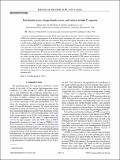| dc.contributor.author | Dai, Zhehao | |
| dc.contributor.author | Zhang, Yahui | |
| dc.contributor.author | Senthil, T | |
| dc.contributor.author | Lee, Patrick A | |
| dc.date.accessioned | 2018-05-21T14:42:27Z | |
| dc.date.available | 2018-05-21T14:42:27Z | |
| dc.date.issued | 2018-05 | |
| dc.date.submitted | 2018-04 | |
| dc.identifier.issn | 2469-9950 | |
| dc.identifier.issn | 2469-9969 | |
| dc.identifier.uri | http://hdl.handle.net/1721.1/115534 | |
| dc.description.abstract | A recent scanning tunneling microscopy (STM) experiment reports the observation of a charge-density wave (CDW) with a period of approximately 8a in the halo region surrounding the vortex core, in striking contrast to the approximately 4a period CDWs that are commonly observed in the cuprates. Inspired by this work, we study a model where a bidirectional pair-density wave (PDW) with period 8 is at play. This further divides into two classes: (1) where the PDW is a competing state of the d-wave superconductor and can exist only near the vortex core where the d-wave order is suppressed and (2) where the PDW is the primary order, the so-called “mother state” that persists with strong phase fluctuations to high temperature and high magnetic field and lies behind the pseudogap phenomenology. We study the charge-density wave structures near the vortex core in these models. We emphasize the importance of the phase winding of the d-wave order parameter. The PDW can be pinned by the vortex core due to this winding and become static. Furthermore, the period-8 CDW inherits the properties of this winding, which gives rise to a special feature of the Fourier transform peak, namely, it is split in certain directions. There is also a line of zeros in the inverse Fourier transform of filtered data. We propose that these are key experimental signatures that can distinguish between the PDW-driven scenario from the more mundane option that the period-8 CDW is primary. We discuss the pro's and con's of the options considered above. Finally, we attempt to place the STM experiment in the broader context of pseudogap physics of underdoped cuprates and relate this observation to the unusual properties of x-ray scattering data on CDW carried out to very high magnetic field. | en_US |
| dc.description.sponsorship | National Science Foundation (U.S.) (Grant DMR1522575) | en_US |
| dc.description.sponsorship | United States. Department of Energy (Grant DE-SC0008739) | en_US |
| dc.publisher | American Physical Society | en_US |
| dc.relation.isversionof | http://dx.doi.org/10.1103/PhysRevB.97.174511 | en_US |
| dc.rights | Article is made available in accordance with the publisher's policy and may be subject to US copyright law. Please refer to the publisher's site for terms of use. | en_US |
| dc.source | American Physical Society | en_US |
| dc.title | Pair-Density Waves, Charge-Density Waves, and Vortices in High- Tc Cuprates | en_US |
| dc.type | Article | en_US |
| dc.identifier.citation | Dai, Zhehao et al. "Pair-Density Waves, Charge-Density Waves, and Vortices in High- Tc Cuprates." Physical Review B 97, 17 (May 2018): 174511 © 2018 American Physical Society | en_US |
| dc.contributor.department | Massachusetts Institute of Technology. Department of Physics | en_US |
| dc.contributor.mitauthor | Dai, Zhehao | |
| dc.contributor.mitauthor | Zhang, Yahui | |
| dc.contributor.mitauthor | Senthil, T | |
| dc.contributor.mitauthor | Lee, Patrick A | |
| dc.relation.journal | Physical Review B | en_US |
| dc.eprint.version | Final published version | en_US |
| dc.type.uri | http://purl.org/eprint/type/JournalArticle | en_US |
| eprint.status | http://purl.org/eprint/status/PeerReviewed | en_US |
| dc.date.updated | 2018-05-14T18:00:22Z | |
| dc.language.rfc3066 | en | |
| dc.rights.holder | American Physical Society | |
| dspace.orderedauthors | Dai, Zhehao; Zhang, Ya-Hui; Senthil, T.; Lee, Patrick A. | en_US |
| dspace.embargo.terms | N | en_US |
| dc.identifier.orcid | https://orcid.org/0000-0002-3789-5683 | |
| dc.identifier.orcid | https://orcid.org/0000-0001-9493-1743 | |
| dc.identifier.orcid | https://orcid.org/0000-0001-7809-8157 | |
| mit.license | PUBLISHER_POLICY | en_US |
